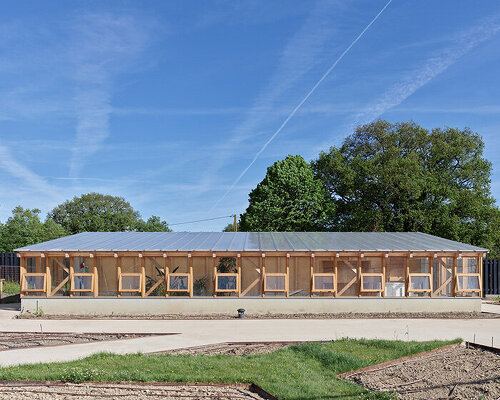Guinée et Potin revamps french biodiversity discovery center
Guinee*Potin Architects breathes new life into a former biodiversity discovery center in La Roche-sur-Yon, Vendée, France, transforming it into Le Potager Extraordinaire, a 1,150-square-meter agro-ecological park. Built around the themes of agricultural, domestic, and vegetable biodiversity, the park immerses visitors in curated edible gardens, greenhouses, and organic cultivation zones, all shaped by a low-impact, bioclimatic architectural vision.
The new structures, which supplement the original Maison de Georges Durand and its thatched addition, take cues from local rural typologies. Timber-framed buildings, clad in a mix of translucent and black-tinted materials, minimize environmental impact through dry construction methods and natural materials like wood, thatch, and raw earth. The ‘ecological’ greenhouse exemplifies this ethos with its north-south-oriented volume constructed from straw-insulated timber frames and finished with rammed earth, maximizing solar gain and leveraging hydraulic openings for natural ventilation.
Selected as one of the 50 projects representing France at the 19th Venice Architecture Biennale, Le Potager Extraordinaire teaches how local resources, modest interventions, and traditional know-how can generate lasting environmental impact.
all images by Stéphane Chalmeau, courtesy of Guinee*Potin Architects
principles of bioclimatic design shape Le Potager Extraordinaire
Guinee*Potin Architects’ design preserves the existing ecological rhythms of the site while welcoming the public into a richly programmed landscape. Prioritizing sustainability and education, the design respects the ecological sensitivity of the site and updates its identity into a landscape for learning and discovery. Using the ERC approach—avoid (éviter), reduce (réduire), and offset (compenser)—the Nantes-based team minimizes disruption to wetland areas and balances necessary interventions with ecological enhancements such as protective plantings and soil restoration. Rooted in the principles of bioclimatic design, the architecture leverages solar orientation, passive ventilation, and local materials to minimize its footprint.
Le Potager Extraordinaire is a living archive of edible plant diversity, designed to educate and delight. Themed gardens guide visitors through curated plant collections, with options for both guided and self-guided tours. An organic cultivation plot supports food production, tying botanical wonder back to everyday practice.
the project breathes new life into a former biodiversity discovery center in France
the new structures take cues from local rural typologies
timber-framed buildings, clad in a mix of translucent and black-tinted materials, minimize environmental impact
the park immerses visitors in curated edible gardens, greenhouses, and organic cultivation zones
wood, thatch, and raw earth compose Le Potager Extraordinaire
built around the themes of agricultural, domestic, and vegetable biodiversity
the architects use dry construction methods and natural materials
shaped by a low-impact, bioclimatic architectural vision
Guinee*Potin Architects’ design preserves the existing ecological rhythms of the site
Le Potager Extraordinaire is one of the 50 projects representing France at the 19th Venice Architecture Biennale
project info:
name: Le Potager Extraordinaire | @lepotagerextraordinaire
architect: Guinee*Potin Architects | @guineepotin
location: La Roche-sur-Yon, Vendée, France
surface area: 1,150 square meters
operator: Le Potager Extraordinaire (Groupe Estille)
landscape architect (lead): Guillaume Sevin Paysages
engineering (BET): OTEIS
client: La Roche-sur-Yon Agglomération | @larochesuryonfr
photographer: Stéphane Chalmeau | @schalmeau
The post guinee*potin’s agro-ecological park revives french site through timber and translucent skins appeared first on designboom | architecture & design magazine.

